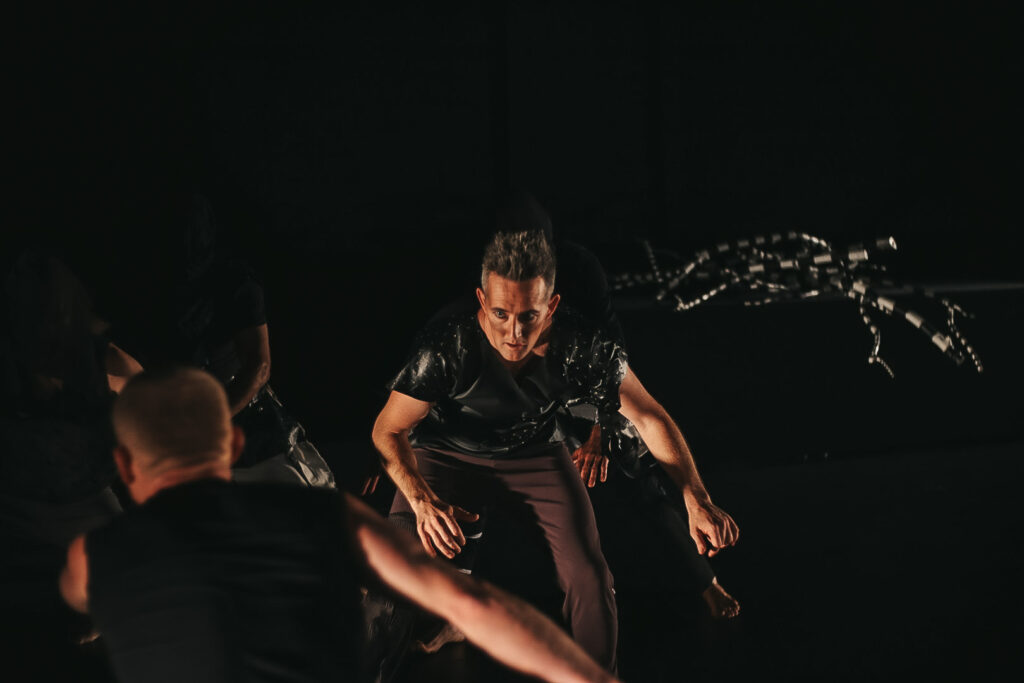In The Beauty Index, choreographer Annette Carmichael offers a future for masculinity that embraces softness as much as strength.
Dreams of dancing men
3 May 2021
- Reading time • 7 minutesDance
More like this
- How to watch ballet
- STRUT Dance comes of age
- Fairytale leaps to life with fun twist
The Beauty Index, Annette Carmichael Projects ·
Mandurah Performing Arts Centre, 1 May 2021 ·
Review by Leigh Reddall ·
For what a mystery a boy is … how easy it is to forget what beautiful creatures they are. There’s so much about them and in them that’s lovely. Graceful. Dreamy. Vulnerable. Qualities we either don’t notice, or simply blind ourselves to.
Tim Winton, About the Boys
There’s precious little room for Tim Winton’s vulnerability in the stereotype of the Aussie bloke who says little, but can lift heavy things and kick a footie… after a few beers.
Annette Carmichael’s The Beauty Index flips this cultural stereotype on its head, however, paving the way for a new type of masculinity that celebrates the beauty Winton describes. Produced and choreographed by Carmichael, this community dance project is performed by a cast of male dancers, ranging in experience from professional to no-training-prior-to-this-project.

Each iteration of this project begins by inviting men in regional WA communities to be part of the making and performance of The Beauty Index. Exploring the idea that fear and violence may be alleviated by beauty and compassion, The Beauty Index is a dance work that was originally created by Carmichael with men from the Great Southern in 2017, and the first work in a three-part triology. This one-night-only performance at Mandurah Performing Arts Centre is part of a tour that also includes Ravensthorpe, Kalgoorlie, Moora and Harvey. At every location a new cast is mentored by Carmichael, a professional dancer (Russell Thorpe on this tour), and four original community cast members. In Mandurah, they are joined by five untrained local dancers.
A barren landscape of black and white striped branches occupies the space. Designed by Kevin Draper and Indra Geidans, the branches reach upwards, like a forest after fire. Dimmed lights create shadows, and sounds echo – is it a bird calling or the cries of men? Movers silently and solemnly enter, wielding totems of striped branches. We see a ritual of building fire, a rite of passage, the dancers moving methodically to place their branches in the space before they begin grounding and exerting their strength through trance-like arm sequences; repetitive, percussive and angular.
The soundscape, by James Gentle, layers deep tonal singing and pulsing, heart-like rhythms that ebb and flow. The movers manipulate their branches, leaning and reaching beyond, as if caged. They carry their metaphorical “weight of the world” ceremoniously, gently placing in varying formations.
In the lead role of Beauty, Russell Thorpe is ethereal; floating and undulating. Beauty rolls his arms in winglike movements, as though prising the anger out of another dancer (soloist Carl Heslop) who sits on the precipice of relaxing into his own beauty, while fighting and holding onto his strength and masculinity. This dancer cries out in anger and frustration, before finally allowing the powers of “beauty” to infiltrate his body.

Thorpe, as Beauty, teeters between softness and strength. Masculine and powerful, his distanced glances to the other dancers and fluid, grounded movement are bewitching. He seems to peel away the layers of the men on stage, offering an alternative to their movement and mindset, a conduit to a more gentle side.
The ensemble dancers linger on the edge – movements bubble from limbs and uncontrollably shake their bodies, only to be replaced with softer qualities, showing glimmers of freedom and lightness.
There’s a deep conviction to the untrained dancers. The significance of what it means to them to be on stage – vulnerable yet strong and expressive – is palpable. It’s a credit to Carmichael’s ability to draw out each dancer’s power and presence.
As a result of the recent Covid lockdown and restrictions, the project lost days of precious rehearsal time. Not surprisingly, then, it feels like each section of this piece could be fleshed out and explored more; that each dancer could reveal themselves in greater detail. That said, the performance felt succinct and polished, holding the audience’s focus and attention with ease.
The Beauty Index program states, “We are more than our words … we speak physically, through our movements … our message is clear … men can dance.” And indeed we see that men can (more than) dance. They can be emotive, move, engage, soften, connect and project. They can be examples for future generations and celebrate themselves.
They can offer a future full of hope, as graceful, dreamy, strong, vulnerable men – qualities that reside within all of them.
The Beauty Index will be presented at Harvey Recreational and Cultural Centre, 5 May 2021.
Read more about Annette Carmichael.
Picture top: L-R Todd Anderson, Jonas Carnegie in ‘The Beauty Index’, Mandurah. Photo: Mark Labrow

Like what you're reading? Support Seesaw.






